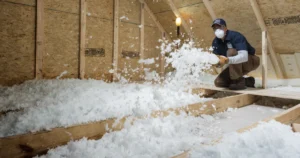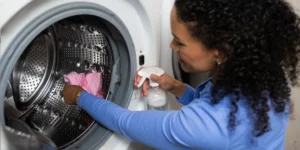High-humidity areas in your home, like bathrooms, kitchens, basements, and laundry rooms, are prime spots for mold and mildew growth. These fungi thrive in damp environments and can lead to health problems, unpleasant odors, and damage to your home. Fortunately, there are several simple steps you can take to prevent mold and mildew from taking hold in your home’s high-humidity areas. Here’s how to keep mold and mildew at bay and ensure a healthier, fresher living space.
1. Improve Ventilation
One of the most effective ways to prevent mold and mildew in high-humidity areas is to improve airflow and ventilation. Proper ventilation helps reduce moisture buildup, which is key in keeping these unwanted fungi away.
- How to improve ventilation:
- Use exhaust fans: Install or use exhaust fans in bathrooms, kitchens, and laundry rooms to vent moist air outside. Run the fan for at least 30 minutes after a shower or cooking to ensure all moisture is removed.
- Open windows and doors: Whenever possible, open windows and doors to let in fresh air. Cross-ventilation, where air flows freely through a space, helps reduce humidity levels inside.
- Consider installing a ceiling fan: In high-humidity areas like bathrooms, adding a ceiling fan can improve airflow and help keep moisture at manageable levels.
- Why it works: Ventilation allows moisture to escape from high-humidity areas, reducing the conditions that promote mold and mildew growth.
2. Use a Dehumidifier
In areas where ventilation is limited, such as basements or small bathrooms, using a dehumidifier can help control humidity levels and prevent mold and mildew.
- How to use a dehumidifier:
- Choose the right size: Select a dehumidifier that’s appropriately sized for the room. Larger spaces will require a higher-capacity unit to remove moisture efficiently.
- Monitor humidity levels: Aim to keep indoor humidity levels between 30-50%. Most dehumidifiers have built-in sensors that allow you to set and maintain the desired humidity level.
- Empty and clean the dehumidifier: Regularly empty the water tank and clean the filter to ensure the dehumidifier operates efficiently.
- Why it works: Dehumidifiers help reduce excess moisture in the air, making it harder for mold and mildew to grow. By keeping humidity levels in check, you create a less inviting environment for these fungi.
3. Wipe Down Surfaces Regularly
Mold and mildew can quickly form on damp surfaces, so it’s important to regularly wipe down areas prone to moisture buildup, such as bathroom tiles, shower walls, kitchen countertops, and laundry room appliances.
- How to prevent moisture buildup:
- Dry wet surfaces: After showering, cooking, or doing laundry, take a few minutes to wipe down any wet surfaces with a dry cloth or squeegee. This helps remove moisture before mold has a chance to form.
- Clean bathroom and kitchen tiles: In bathrooms and kitchens, where moisture is constant, clean tiles and grout regularly with a mixture of water and vinegar to prevent mildew from taking hold.
- Keep appliances dry: Dry the interior of washing machines, dishwashers, and refrigerators regularly, especially if they are located in high-humidity areas.
- Why it works: By wiping down wet surfaces, you remove excess moisture and create an environment where mold and mildew cannot thrive. This small step can go a long way in preventing their growth.
4. Fix Leaks and Drips Immediately
Even small leaks or drips can create the perfect breeding ground for mold and mildew. If you have any leaks in your plumbing, roof, or appliances, it’s important to address them as soon as possible.
- How to fix leaks:
- Check for leaks regularly: Inspect areas under sinks, around faucets, behind appliances, and near windows for signs of water leaks. If you notice any drips, discoloration, or musty smells, there may be a leak present.
- Fix plumbing issues: Tighten loose connections, replace worn washers, or hire a plumber to fix more significant issues. The longer a leak is left unchecked, the more likely mold will develop.
- Seal gaps and cracks: Inspect windows, doors, and other areas where water might enter during rain or storms. Use caulk or weatherstripping to seal any gaps and prevent water intrusion.
- Why it works: Eliminating leaks and drips ensures that excess moisture doesn’t accumulate in hidden or hard-to-reach areas, where mold and mildew can flourish undetected.
5. Use Mold-Resistant Products
When renovating or upgrading your home, consider using mold-resistant products in high-humidity areas. These materials are designed to resist mold growth, making it harder for fungi to take hold in damp environments.
- How to use mold-resistant products:
- Mold-resistant drywall: If you’re remodeling a bathroom or basement, use mold-resistant drywall (also called green board) in moisture-prone areas. It’s specifically designed to withstand humid conditions.
- Mold-resistant paint: In bathrooms, kitchens, or laundry rooms, opt for mold-resistant paint on walls and ceilings. These paints contain antimicrobial agents that help prevent the growth of mold and mildew.
- Moisture-resistant flooring: Consider moisture-resistant flooring options, such as tile, vinyl, or sealed concrete, in areas where water exposure is common. These materials are less prone to absorbing moisture than hardwood or carpet, reducing the risk of mold.
- Why it works: Mold-resistant materials and paints add an extra layer of protection, helping to keep mold and mildew from growing in damp environments.
6. Keep Humidity Levels Low
Controlling humidity levels throughout your home is one of the most important ways to prevent mold and mildew. High indoor humidity creates the perfect environment for these fungi to grow.
- How to keep humidity low:
- Monitor humidity levels: Use a hygrometer to check the humidity level in different areas of your home. Aim for humidity levels between 30-50%.
- Vent appliances properly: Make sure appliances that generate moisture, such as dryers, stoves, and exhaust fans, are properly vented to the outside to avoid moisture buildup indoors.
- Air conditioners: Use air conditioning during warm months to cool the air and reduce humidity levels inside your home.
- Why it works: Lowering humidity levels makes your home less hospitable to mold and mildew, reducing the likelihood of them forming in the first place.
7. Clean and Maintain Air Ducts
Your home’s HVAC system can contribute to mold and mildew growth if air ducts are not properly maintained. Moisture, dust, and debris can accumulate in ductwork, providing a perfect breeding ground for mold, which can then be spread throughout your home.
- How to maintain air ducts:
- Inspect ducts for mold: Check your air ducts periodically for any signs of mold or mildew growth. If you notice musty smells coming from your vents, it’s a sign there may be mold in the ducts.
- Clean air ducts: Hire a professional to clean your air ducts if there’s visible mold growth or if they haven’t been cleaned in several years.
- Replace air filters: Regularly change your HVAC system’s air filters to improve airflow and reduce dust buildup that can contribute to mold growth.
- Why it works: Keeping your air ducts clean prevents mold spores from spreading through your home’s ventilation system, helping to maintain good indoor air quality and prevent mold infestations.
8. Use Moisture-Absorbing Products
In particularly damp or high-humidity areas, using moisture-absorbing products can help reduce moisture levels and prevent mold and mildew from forming.
- How to use moisture absorbers:
- Silica gel or moisture absorbers: Place silica gel packs or moisture-absorbing products like calcium chloride in closets, bathrooms, or other moisture-prone areas. These products pull excess moisture from the air and help maintain lower humidity levels.
- Charcoal or baking soda: For a more natural option, place bowls of activated charcoal or baking soda in rooms with high humidity to absorb moisture and neutralize odors.
- Why it works: Moisture-absorbing products are an inexpensive and effective way to keep humidity in check, especially in areas where ventilation may be limited.
Final Thoughts: A Mold-Free, Healthier Home
Preventing mold and mildew in high-humidity areas requires regular maintenance and smart home practices. By improving ventilation, controlling humidity levels, and using mold-resistant materials, you can create a healthy, mold-free environment for your family. Simple steps like wiping down surfaces, fixing leaks, and using dehumidifiers can make a big difference in keeping your home fresh, clean, and free from mold and mildew.









